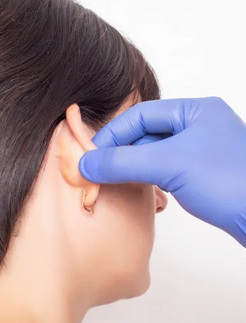Otoplasty
Ear Surgery, clinically known as otoplasty, is a relatively less invasive cosmetic surgery to correct the shape, size, or orientation of your ears. If your ears sag too long, are without symmetry, or protrude too much, you could be a candidate for ear reshaping surgery.
Otoplasty can be used to cosmetically alter one or both of your ears. A plastic surgeon can also reduce the size of your ears or earlobes or perform a cauliflower ear reshaping surgery as part of otoplasty. In case of ear reduction, the surgeon will remove excess cartilage and skin and recontour the shape of your ears to create a natural look.
Ears are a conspicuous part of your face, and you can expect a highly desirable improvement in your facial appearance with otoplasty along with an increase in your self-confidence. If your ear has suffered damage in an accident or has a birth deformity, an ear reconstructive surgery can be performed to restore its natural shape.
Your cosmetic surgeon will typically perform an otoplasty or ear pinning surgery using IV sedation with local anesthesia. They will create a small incision discreetly behind the ears so that any subsequent scarring remains minimally exposed.
What can ear surgery treat?
Overly large ears – a condition called macrotia Protruding ears occurring on one or both sides in varying degrees – not associated with hearing loss. Dissatisfaction with previous ear surgery
Who is a suitable candidate for ear surgery?

Healthy, without a life-threatening illness or untreated chronic ear infections

Healthy individuals who do not have a life-threatening illness or medical conditions that can impair healing

Individuals with a positive outlook and specific goals in mind for ear surgery

Ear surgery is a highly individualized procedure and you should do it for yourself, not to fulfill someone else’s desires or to try to fit any sort of ideal image.
What should you expect during your ear surgery recovery?
Discomfort immediately following ear surgery is normal and can be controlled with pain medication. There may be an itchy feeling under bandages. It is essential that bandages remain intact and are not removed for any reason. Failure to do so may result in loss of some of the correction and may require a secondary surgery.
The practice of medicine and surgery is not an exact science. Although good results are expected, there is no guarantee of complete satisfaction with the results. In some situations, it may not be possible to achieve optimal results with a single surgical procedure and another surgery may be necessary.


When you go home
After surgery, bandages or dressings will be applied to keep your surgical site clean, protect it from trauma and to support the new position of the ear during initial healing.

Be careful
Following your physician’s instructions is key to the success of your surgery. It is important that the surgical incisions are not subjected to excessive force, sunlight or tanning bed light, abrasion or motion during the time of healing. Your doctor will give you specific instructions on how to care for yourself.,

What are the risks of ear surgery?
The decision to have plastic surgery is extremely personal and you will have to weigh the potential benefits in achieving your goals with the risks and potential complications of ear surgery. Only you can make that decision for yourself.

What results should I expect after ear surgery?
Ear surgery offers almost immediate results in cases of protruding ears, visible when the dressings that support the new shape of the ear during initial phases of healing are removed. With the ear permanently positioned closer to the head, surgical scars are either hidden behind the ear or well hidden within the natural creases of the ear.












